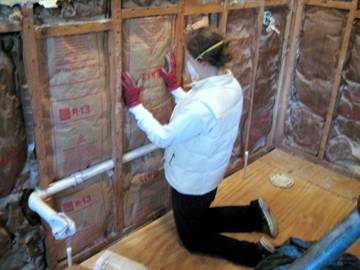Proper Bathroom Insulation
by Mark Row
Top bathroom insulating tips
Bathrooms have a reputation as a demanding insulation projects. When it comes to bathrooms insulation, main problem is moisture control. Hot water used during showering produces steam and increases humidity (the volume of water vapor in the air), which is, if not properly ventilated, than trapped in the bathroom walls, causing mildew growth and endangering your health. This is why bathrooms are more complex project than other areas of the house. It doesn’t mean you can’t do this job yourself, just that you have to know what to look out for and fallow the specs and procedures to the letter. Humidity problem can be solved by installing a vapor barrier around the walls and on the floor.
Plan your bathroom insulating project in stages, tackling one thing at the time.
What needs to be insulated?
Properly insulated bathroom reduces energy consumption and saves money. To accomplish this, you have to insulate interior walls and hot water pipes, to minimize heat loss.
Insulating interior bathroom walls
Place the insulation slabs or batts inside the wall cavity, between the studs. If the whole batt cannot fit inside the cavity, cut off the excess material with a scalpel knife, leaving a couple of centimeters over on each side to ensure a tight fit. Use the discarded material to fill gaps, nooks and crannies. You can tuck the smaller pieces in using a screwdriver.

To prevent moisture from penetrating inside the insulation you need to install a vapor-diffusion barrier (vapor barrier) that reduces the rate at which moisture moves through the material, preventing the occurrence of mold. Vapor-diffusion retarder (VDR for short) should be placed toward the interior of the room.
Insulating Pipes
Clean the pipes first and prepare the material. Use a cloth to remove grease and/or dirt from the pipes. Leave them to completely dry before you start to insulate. Foil, fiberglass and wool insulation is wrapped around the pipe. For example, Knauf’s Earthwool pipe insulation belongs to a new generation of products, made from sustainable and renewable bio-based materials. But if you are not too particular, any above stated type of insulation will do the job just fine.
Entire pipe must be enveloped and, if needed, each end of the insulation should be secured with tape. Fixing the insulation is not very hard because it usually comes in a tubular shape, as a self-sealing lap ready to be mounted on a pipe. You just have to pick the size you need and cut it to lengthwise to measure.
If you found this article to be helpful, please share it with your friends on Twitter, Facebook and Google+. If you have any questions or comments feel free to write them in the comment section below, I will respond to all of them.


























































































































